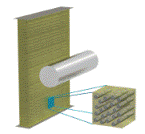Mechanical and Materials Engineering, Department of

Department of Engineering Mechanics: Dissertations, Theses, and Student Research
Date of this Version
8-2012
Document Type
Thesis
Abstract
Environmental concerns have been motivating research in the field of biodegradable materials, especially those from biological sources. Polylactic acid (PLA) is one biopolymer with the potential to replace some standard synthetic polymers. PLA is currently used for fibers, medical sutures, and some packaging, but is still used very little compared with synthetic polymers. One thing that can be done to expand the potential applications of PLA is to add fibers to create composite materials. Bamboo is a good choice for these fibers because it is abundant in many parts of the world, grows very quickly, and is widely unused. Composites were created from PLA and short bamboo fibers, and their mechanical and thermal properties were examined. Samples were fabricated by mixing PLA pellets and bamboo fibers and extruding the mixture with a single-screw extruder. The extruded material was collected and compression molded. Bamboo fibers were alkali treated with sodium hydroxide (NaOH) before extrusion. Samples were created with four different treated fiber concentrations: 5%, 10%, 20%, and 40% by weight. Samples with 20% untreated fibers and samples of pure PLA were created with the same fabrication parameters and tested for comparison. The mechanical properties of the bulk composites were analyzed with three-point bending and Charpy impact tests, as well as dynamic mechanical analysis. Thermogravimetric analysis and dynamic mechanical analysis were used to examine thermal properties. Nanoindentation and scanning electron microscopy were used to study the properties of the embedded fibers and the morphology of the matrix-fiber interface. Some theoretical modeling was also conducted to better understand the experimental results. The results show no significant improvement in properties was achieved through the addition of bamboo fibers to the PLA. The poor composite performance is attributed to weak interfacial strength between neighboring fibers and inefficient fiber length.
Adviser: Joseph A. Turner


Comments
A thesis Presented to the Faculty of The Graduate College at the University of Nebraska In Partial Fulfillment of the Requirements For the Degree of Master of Science, Major: Engineering Mechanics, Under the Supervision of Professor Joseph A. Turner. Lincoln, Nebraska: August, 2012
Copyright (c) 2012 Sarah E. Royse